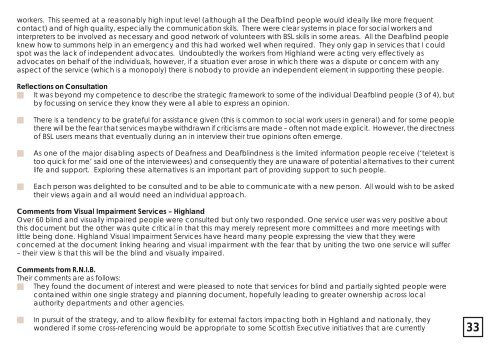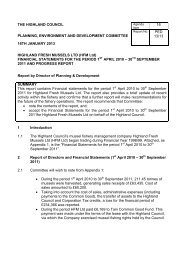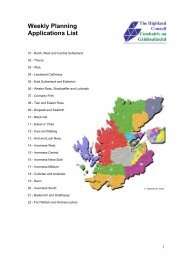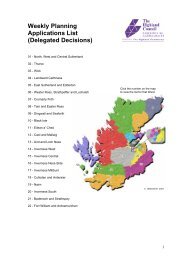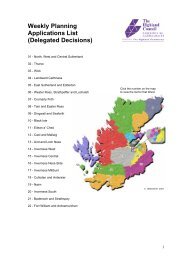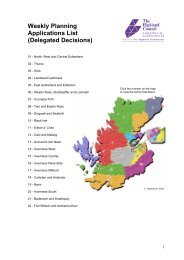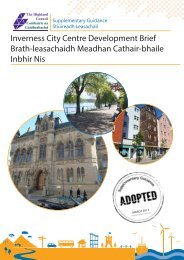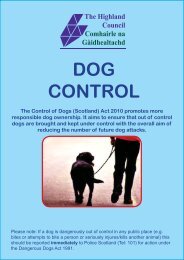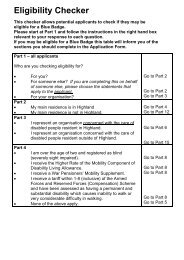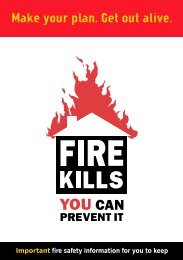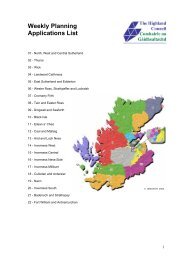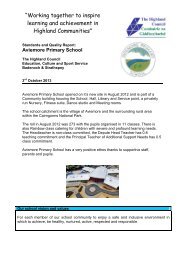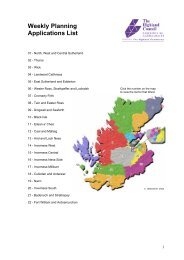A Single Strategy for Sensory Needs - The Highland Council
A Single Strategy for Sensory Needs - The Highland Council
A Single Strategy for Sensory Needs - The Highland Council
Create successful ePaper yourself
Turn your PDF publications into a flip-book with our unique Google optimized e-Paper software.
workers. This seemed at a reasonably high input level (although all the Deafblind people would ideally like more frequent<br />
contact) and of high quality, especially the communication skills. <strong>The</strong>re were clear systems in place <strong>for</strong> social workers and<br />
interpreters to be involved as necessary and good network of volunteers with BSL skills in some areas. All the Deafblind people<br />
knew how to summons help in an emergency and this had worked well when required. <strong>The</strong>y only gap in services that I could<br />
spot was the lack of independent advocates. Undoubtedly the workers from <strong>Highland</strong> were acting very effectively as<br />
advocates on behalf of the individuals, however, if a situation ever arose in which there was a dispute or concern with any<br />
aspect of the service (which is a monopoly) there is nobody to provide an independent element in supporting these people.<br />
Reflections on Consultation<br />
It was beyond my competence to describe the strategic framework to some of the individual Deafblind people (3 of 4), but<br />
by focussing on service they know they were all able to express an opinion.<br />
<br />
<br />
<br />
<strong>The</strong>re is a tendency to be grateful <strong>for</strong> assistance given (this is common to social work users in general) and <strong>for</strong> some people<br />
there will be the fear that services maybe withdrawn if criticisms are made – often not made explicit. However, the directness<br />
of BSL users means that eventually during an in interview their true opinions often emerge.<br />
As one of the major disabling aspects of Deafness and Deafblindness is the limited in<strong>for</strong>mation people receive (‘teletext is<br />
too quick <strong>for</strong> me’ said one of the interviewees) and consequently they are unaware of potential alternatives to their current<br />
life and support. Exploring these alternatives is an important part of providing support to such people.<br />
Each person was delighted to be consulted and to be able to communicate with a new person. All would wish to be asked<br />
their views again and all would need an individual approach.<br />
Comments from Visual Impairment Services – <strong>Highland</strong><br />
Over 60 blind and visually impaired people were consulted but only two responded. One service user was very positive about<br />
this document but the other was quite critical in that this may merely represent more committees and more meetings with<br />
little being done. <strong>Highland</strong> Visual Impairment Services have heard many people expressing the view that they were<br />
concerned at the document linking hearing and visual impairment with the fear that by uniting the two one service will suffer<br />
– their view is that this will be the blind and visually impaired.<br />
Comments from R.N.I.B.<br />
<strong>The</strong>ir comments are as follows:<br />
<strong>The</strong>y found the document of interest and were pleased to note that services <strong>for</strong> blind and partially sighted people were<br />
contained within one single strategy and planning document, hopefully leading to greater ownership across local<br />
authority departments and other agencies.<br />
<br />
In pursuit of the strategy, and to allow flexibility <strong>for</strong> external factors impacting both in <strong>Highland</strong> and nationally, they<br />
wondered if some cross-referencing would be appropriate to some Scottish Executive initiatives that are currently 33


